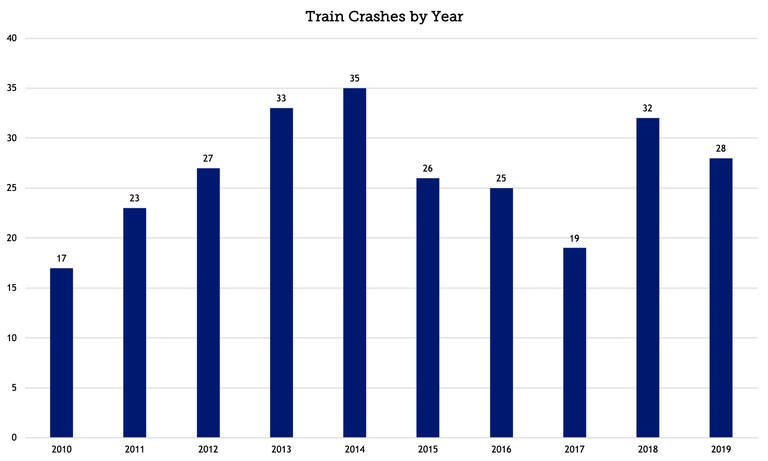Coloradans reminded to use caution around trains during Rail Safety Week
DENVER — The Colorado Department of Transportation (CDOT) is reminding motorists, pedestrians and bicyclists to always use caution when approaching a rail crossing on any roadway in Colorado. Monday, September 21 through Sunday, September 27 is Rail Safety Week (RSW). The goal of RSW is to raise awareness of the need for rail safety education and empower the general public to be safe near highway-rail grade crossings and railroad rights-of-way.
Operation Lifesaver, Inc., a national rail safety education organization, works in partnership with the U.S. Department of Transportation and other organizations to observe Rail Safety Week each year. The organization’s "Stop Track Tragedies" public awareness campaign shows the impact that rail-related incidents have on families - and communities.
In addition, videos by CDOT provide warnings about crossing railroad tracks where there may not be gates or signals, known as passive crossings. Such crossings are common in rural areas of the state. In urban areas RTD has released it’s own video on the importance of rail safety.
In 2019 four people were killed and seven were injured in 28 vehicle-train crashes in Colorado. Since 2010 there have been more than 265 train crashes at railroad crossings in the state.

Every year in North America, 2,100 people are killed or seriously injured around tracks and trains — often at at-grade crossings.
“In Colorado, and nationwide, safety at railroad grade crossings is a critical issue that we must address through improvements in signals and by reinforcing the need for all travelers to be extremely careful at these intersections” said Sam Cole, Traffic Safety Communications Manager at CDOT.
Operation Lifesaver works with CDOT to prevent crashes. Upgrading high accident exposure at grade railroad crossings statewide with warning lights and gates is part of the CDOT Whole System Whole Safety program.
By law, trains always have the right of way, and avoiding a train collision is the responsibility of the driver, pedestrian, bicyclist or motorcyclist. A train cannot swerve, stop quickly or change directions to avert a collision. A train traveling at 55 mph requires a mile to stop – the length of more than 17 football fields – after applying the emergency brakes.
CDOT urges motorists to follow these tips to stay safe at railroad crossings:
- When approaching a railroad crossing, slow down, look and listen for a train on the tracks, especially at passive crossings where there are no gates or warning signals.
- Look carefully in both directions before crossing a rail track, even during the day.
- Do not rely on past experience to guess when a train is coming. Trains can travel from either direction at any time.
- Never race a train. It is easy to misjudge a train’s speed and distance from a crossing.
- Before entering a railroad crossing, check that there is enough room on the other side of the tracks for your vehicle to cross completely and safely. Be aware that you may need to cross multiple sets of tracks at some railroad crossings.
- Never stop on railroad tracks. Keep moving once you have entered the crossing. To avoid a vehicle stalling, never shift gears on the tracks.
- If your vehicle stalls on a railroad track, quickly move away from the track and your vehicle at a 45-degree angle. Call the phone number on the Emergency Notification System sign or, if the sign is not visible to you, dial 911 for help.
In 2018, nationally 270 people were killed at railroad crossings, according to data from the Federal Railroad Administration which was a 10-year high. Of those, 99 people died after the driver went around lowered crossing gate arms. In fact, from 2014–2018, the 1,538 drivers that were struck accounted for 14 percent of all train collisions—these were preventable crashes caused by risky driving behaviors and poor decision-making.
WHOLE SYSTEM. WHOLE SAFETY.
To heighten safety awareness, CDOT recently announced its Whole System — Whole Safety initiative. This project takes a systematic statewide approach to safety combining the benefits of CDOT’s programs that address driving behaviors, our built environment and the organization's operations. The goal is to improve the safety of Colorado’s transportation network by reducing the rate and severity of crashes and improving the safety of all transportation modes. The program has one simple mission—to get everyone home safely.
ABOUT CDOT
CDOT has approximately 3,000 employees located at its Denver headquarters and in regional offices throughout Colorado, and manages more than 23,000 lane miles of highway and 3,429 bridges. CDOT also manages grant partnerships with a range of other agencies, including metropolitan planning organizations, local governments and airports. It also administers Bustang, the state-owned and operated interregional express service. Governor Polis has charged CDOT to further build on the state’s intermodal mobility options.
